Bronze / Emily Nyburg, Anna Meddaugh, Behnia Rahmati, Ariane Fund, David Hollo, Marie Stargala / Safe Niños: PlayScape
Bronze / Alvin Oei, Dave Kim, Nicholas Jayanty, Lori Nishikawa, Su-Sun Kwak, Belle Lee/ Safe Niños: Healing Tree
Finalist / Behnia Rahmati, Anna Meddaugh / Safe Niños: TeenZone
COANIQUEM: Safe Niños Designing Innovative Interactive Environments for Pediatric Healing
- Global Health
- Social Entrepreneurship
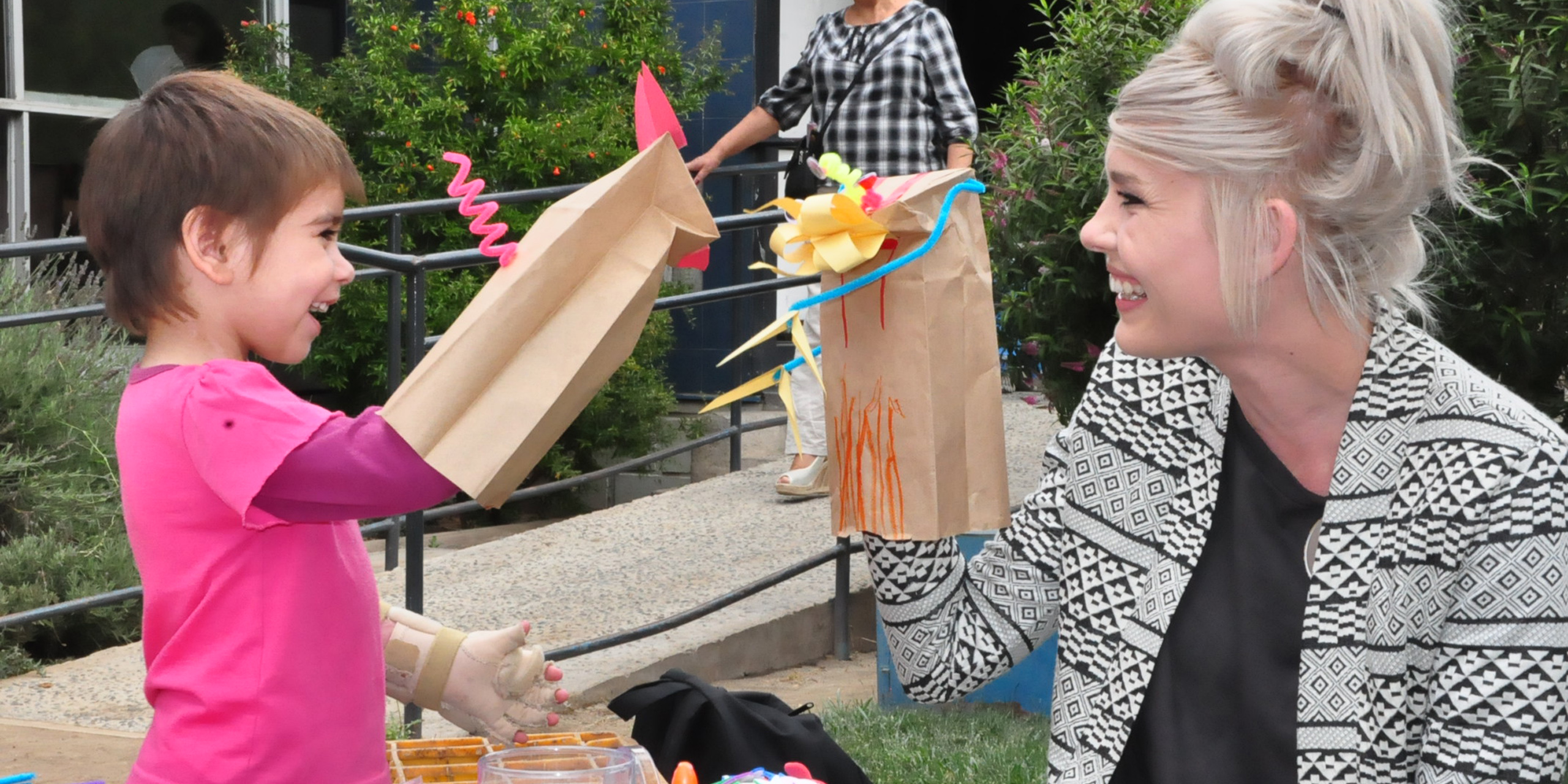
Spring 2016
In partnership with COANIQUEM, a nonprofit pediatric treatment facility in Santiago, Chile, that cares for young burn survivors free of charge, the “Safe Niños” studio challenged students to reimagine the 6-acre campus with human-centered environments that celebrate well-being for patients, their families and medical staff.
Recent Project Developments
Safe Niños Development Seminar
A subset of students from the original studio along with additional students especially recruited for the seminar came together with the Safe Niños faculty and the Designmatters team to develop the vision of the original studio to the next phase of design development. The goal of the seminar focused on cost-effective and innovative ways to bring several of the designs schemes proposed in in the 1st studio to further implementation readiness.
For the latest updates on the Safe Niños Project, check out the COANIQUEM: SAFE NIÑOS DEVELOPMENT SEMINAR case study.
Project Overview
Transdisciplinary ArtCenter students collaborated as a unified team to envision innovative and cost-effective ways to create engaging environments and systems that will support a healing and nurturing atmosphere within the existing campus of COANIQUEM, where young burn survivors across Latin America receive treatment.
Co-creation was paramount to this project as students reached out and established rapport with a variety of stakeholders – pediatric patients, their families, doctors, staff and administration – to create feasible and practical yet highly appealing and connective elements that would present a single redesigned vision.
In Chile, students lived in COANIQUEM’S residential housing, the Casabierta, where burn survivors and their families stay during the often lengthy treatments and therapy sessions. Students observed the internal and external landscape of COANIQUEM, as they gathered field research, witnessed a patient’s typical day, conducted interviews, and brainstormed with stakeholders.
Discovering specific opportunities for improved design and innovation, student teams started their project work while in Chile and, upon their return to ArtCenter’s Pasadena campus, continued to refine their cost-effective yet high-impact ideas of reimagining the campus environment.
“The most powerful aspect of this Designmatters project is the creativity of the ArtCenter students as well as the open-mindedness of the people of COANIQUEM. Very often doctors decide to ‘keep things the same, this is my system, I am very comfortable and I don’t want to change anything.’ That’s not the case with COANIQUEM. Good ideas can mean a revolution and a new era in COANIQUEM. These design ideas means that we can do better, be more holistic, more close to the community, more close to the patients, parents and staff – all who have been participating strongly in this process.”
– Dr. Jorge Rojas, Executive President of COANIQUEM
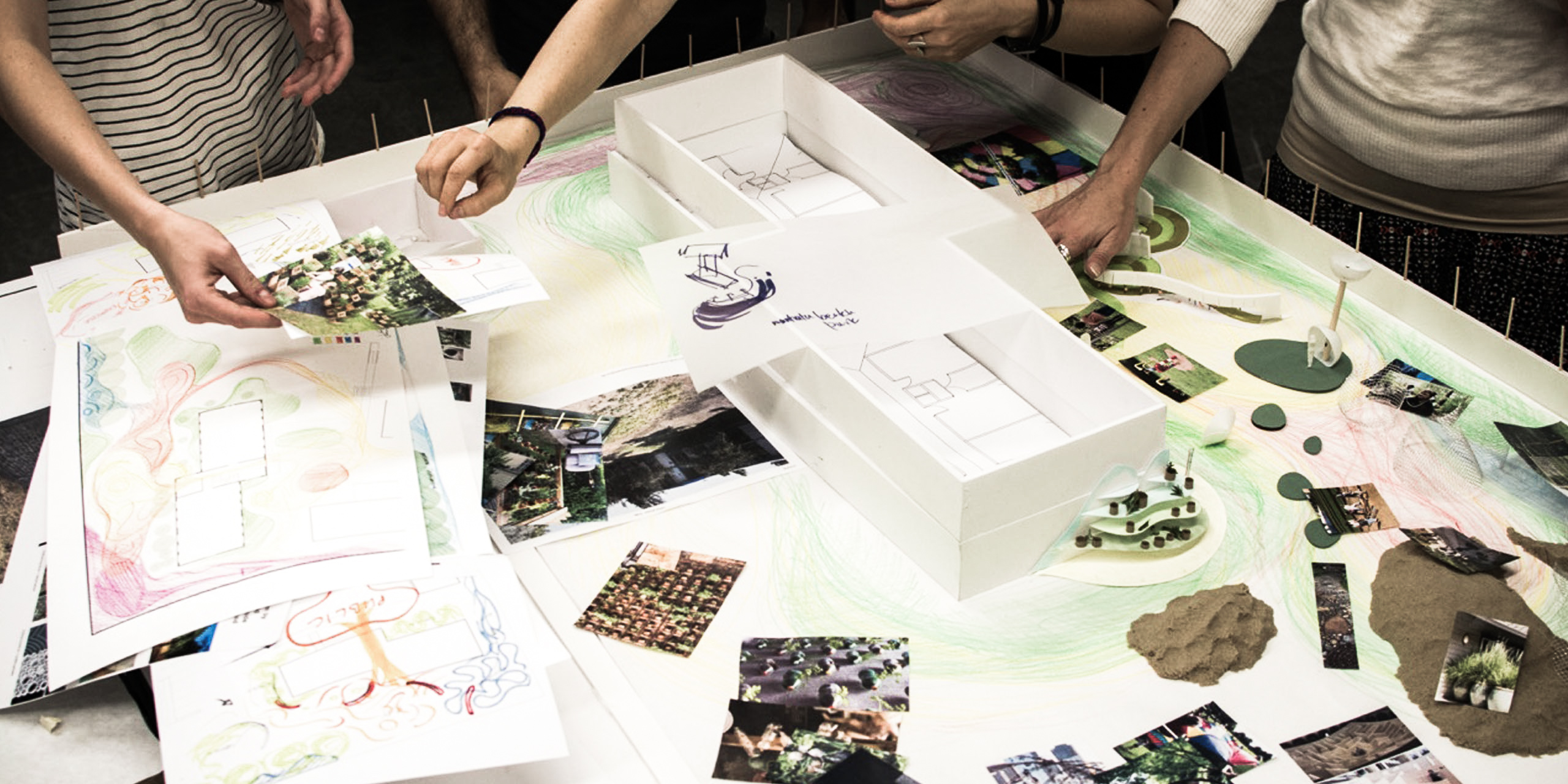
Background
Every year, more than 7 million children across Latin America are victims of burn accidents. In Chile alone, 100,000 burn accidents occur with the majority of accidents involving children aged 5 years or younger.
About 90 percent of burn accidents for children happen at home, even with parents’ supervision. Children are burned by hot liquids, open fires, electrical fires, fireworks and hot elements from heaters and irons. Recovering from a burn – whether small or large – can be painful and often involves extensive follow-up care that can take decades.
For survivors and their families, a burn represents a psychological, emotional as well as physical scar that changes everyone for the rest of their lives.
About Coaniquem
Since its inception in 1979 by Dr. Jorge Rojas-Zeger, COANIQUEM has cared for more than 100,000 children suffering from devastating and life-altering burn injuries. Because of partnerships and international support, Coaniquem can offer their services at no cost to families, many who live in underserved communities..
COANIQUEM treats 8,000 patients annually, with survivors and families living on the facility grounds for weeks and months as they undergo treatments and therapy sessions. The campus is located in a residential neighborhood in Santiago and children and families travel to the Santiago facility from all across South America
Taking a holistic approach, COANIQUEM combines medical attention, restorative healing and comprehensive rehabilitation programs to treat physical and psychological scars. Trained professionals from a wide range of specializations are part of the COANIQUEM facility: medical doctors, registered nurses, physical therapists, occupational therapists, psychologists, social workers and music therapists. Teachers at the on-site school ensure that children of all ages who are undergoing treatments keep up with their education.
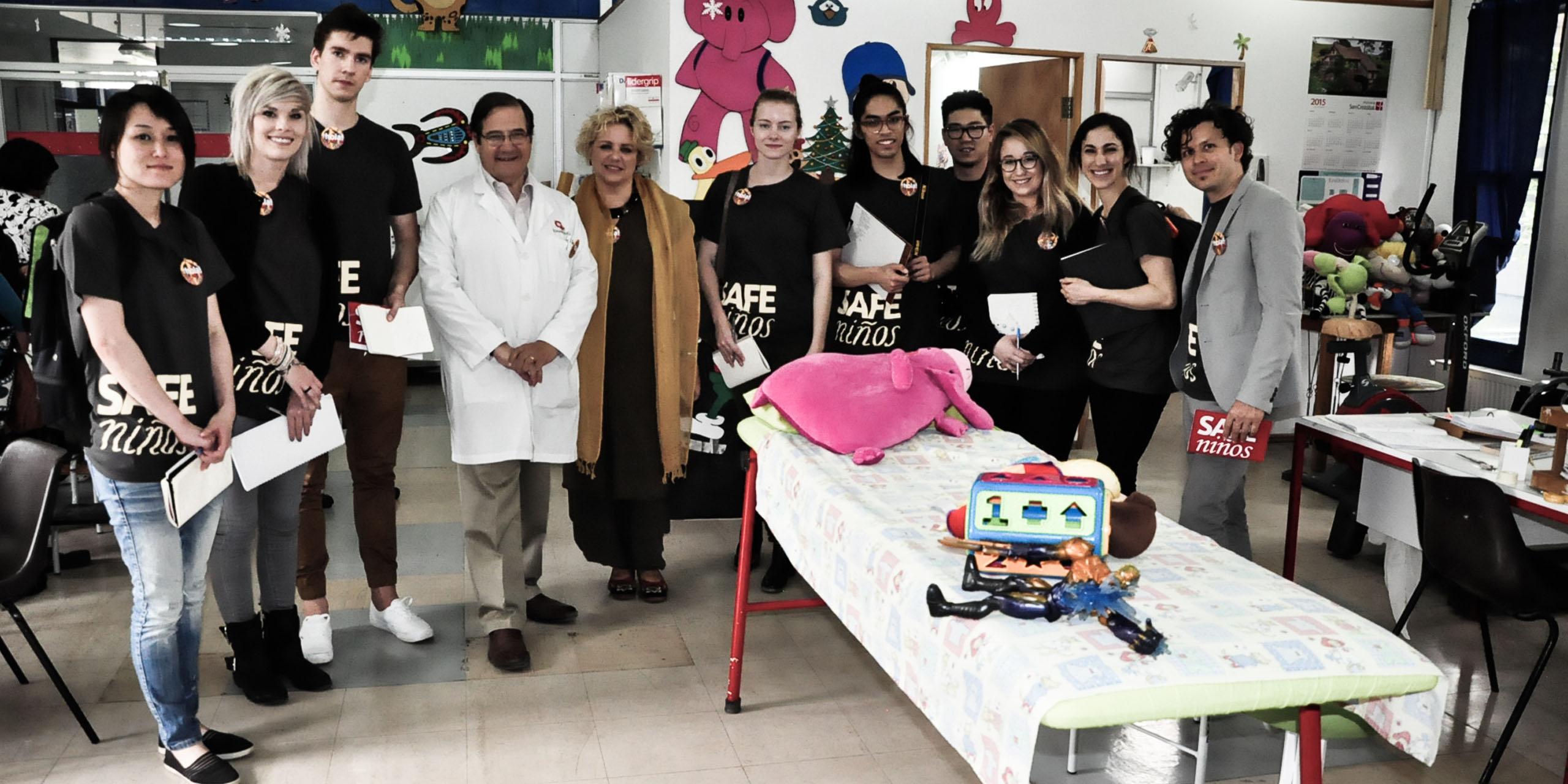
“We talk about co-creation a lot, but I was so proud of how the students were humble and selfless and took that idea to heart. Design can be a profession that can have lots of ego in it, but these students had a larger mission beyond themselves and that allowed them to work not just as a team or as a class, but also as a bigger team with the family of COANIQUEM.”
– Penny Herscovitch, Associate Professor, Environmental Design
Research and Development
Workshop Sessions
Prior to traveling to Chile, students participated in two workshops; one focused on practical tools for collecting data and interviewing techniques followed by a session on sensitivity training with special emphasis on young burn survivors and their families.
ArtCenter instructor Arden Stern led the research and interview technique workshop that provided students with real-world tools for gathering and distilling field data. Students were reminded they would be strangers from another culture (who might not speak the language) and their actions might be scrutinized carefully.
Students learned about informed consent and how they could appropriately approach stakeholders, especially children. They were introduced to the concept of co-framing the problem with stakeholders and to see prompts through other perspectives.
The research workshop provided students with tactics for obtaining informed consent from the various stakeholders, and how they could appropriately approach research subjects on COANIQUEM’S campus, especially pediatric patients. They were introduced to the concept of co-framing the problem with stakeholders and seeing prompts through outside perspectives. Engaging in observational exercises, students practiced a variety of interviewing styles with their colleagues, discussing the pros and cons of unstructured, semi-structured and structured conversations. All in all, students were encouraged to be opportunity seekers, not instant problem solvers.
Also prior to the two-week research trip, Designmatters hosted a sensitivity training workshop for students, facilitated by medical professionals from the Miller Children’s & Women’s Hospital in Long Beach. Dr. Lisa Fasnacht-Hill and Remy Dietz, both child-life specialists, offered students insights on the phases of recovery for burn survivors and their families, as well as how care providers best interact with — and understand — their patients’ specific needs.
The presenters described the holistic healing process from young child to young adult; often, patients and families experience feelings of guilt, anxiety, fear, depression and regression after a traumatic incident. They also outlined helpful reactions when interacting with burn patients and their families, and provided students with therapeutic play activities that effectively engage young patients.
Following their experience in Chile, Safe Niños students and faculty took a field trip to Mattel UCLA Children’s Hospital to research how environmental graphics play into the healing process for young patients. The hospital features colorful and playful adhesive wall treatments throughout the pediatric unit, which create an imaginary and whimsical world for patients. Many of the wall graphics were illustrated by ArtCenter alum Patrick Hruby, in partnership with Blik Design Firm. Students had the opportunity to meet with members of the Child Life Department to further inquire about the healing process for young patients, as well as the various therapeutic spaces on Mattel’s campus.
Field Research/Co-Creation
For two weeks, students were immersed in the culture of COANIQUEM, becoming familiar with their surroundings, connecting with stakeholders for future co-creation opportunities and discovering ways to improve and enhance the COANIQUEM experience.
In small teams, students utilized the new skills they had acquired in the pre-trip workshops by collecting qualitative and quantitative data distilled from their direct observations and understanding. They listened to people’s stories, their dreams and hopes, developing empathy with families, patients and staff members as they learned their daily challenges, both big and small.
Method cards and a research manual pack provided jumping off points and hands-on, human-centered research strategies, allowing students to understand the flow and layout of the campus and how a typical patient and family would engage in the entire COANIQUEM experience from the moment they first entered the front gate. Students witnessed how stakeholders utilized waiting rooms and play areas, and how furniture, lighting and wayfinding methods were employed; in turn, COANIQUEM staff offered students various observational opportunities and guided tours of the facility, revealing insightful moments in all of the stakeholders’ daily behaviors and activities across campus.
In creative arts workshops, students discovered how engaging children with arts and crafts produced opportunities of shared emotions and personal stories, despite language barriers. Brainstorming sessions and interviews with COANIQUEM staff allowed students to prioritize key challenges and opportunities, and envision solutions together.
For their second week in residence, students targeted opportunities and began to ideate specific directions and design concepts. They participated in a studio insight session, sharing their experiences and observations with the whole class.
With these emerging insights, students reached out to stakeholders with the intent of co-creation, allowing this redesigned vision to be a joint concept between students and COANIQUEM’S patients, family members, staff and medical team members.
Through drawing, sketching, quick collages and simple scale models, stakeholders were engaged in co-visioning new environments. Key participants provided honest feedback on direction and possible design. Through these activities, students’ initial assumptions were validated, and they were able to plot strategies for the next phase of design and development.
Additional trips into the city for tours of neighborhoods and museums also provided context for the cultural environment of the people who work at and are served by COANIQUEM.
Upon their return to ArtCenter – and inspired by the holistic nature of the doctors and staff at COANIQUEM – the studio decided to work together as a unified team for a common good, rather than in small student teams, as originally planned. This allowed students to develop one overriding concept with interconnected elements, which featured individual talents and ideas.
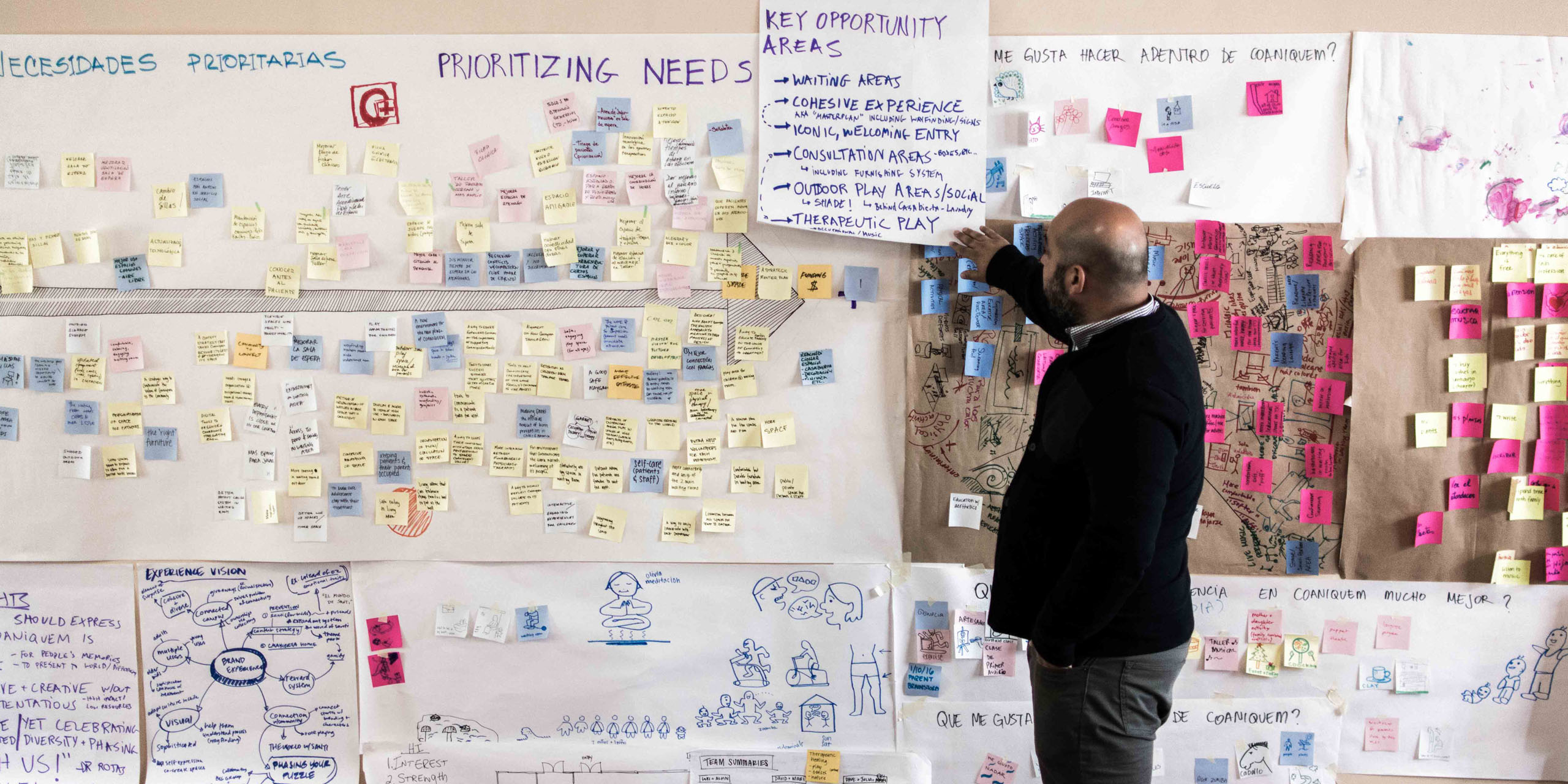
2nd Field Research Trip
While co-creation begins during field research, it does not comprise a single instance or phase, but rather serves as a guiding principle that drives every step in the design process. Ongoing community feedback becomes essential to build trust, understand stakeholders’ priorities and create the most value for the partner community.
After mid-term presentations, a select group of students returned to COANIQUEM to show ideations and conceptual models to staff, parents, patients and doctors for feedback, which further connected students and stakeholders as co-creators of the project.
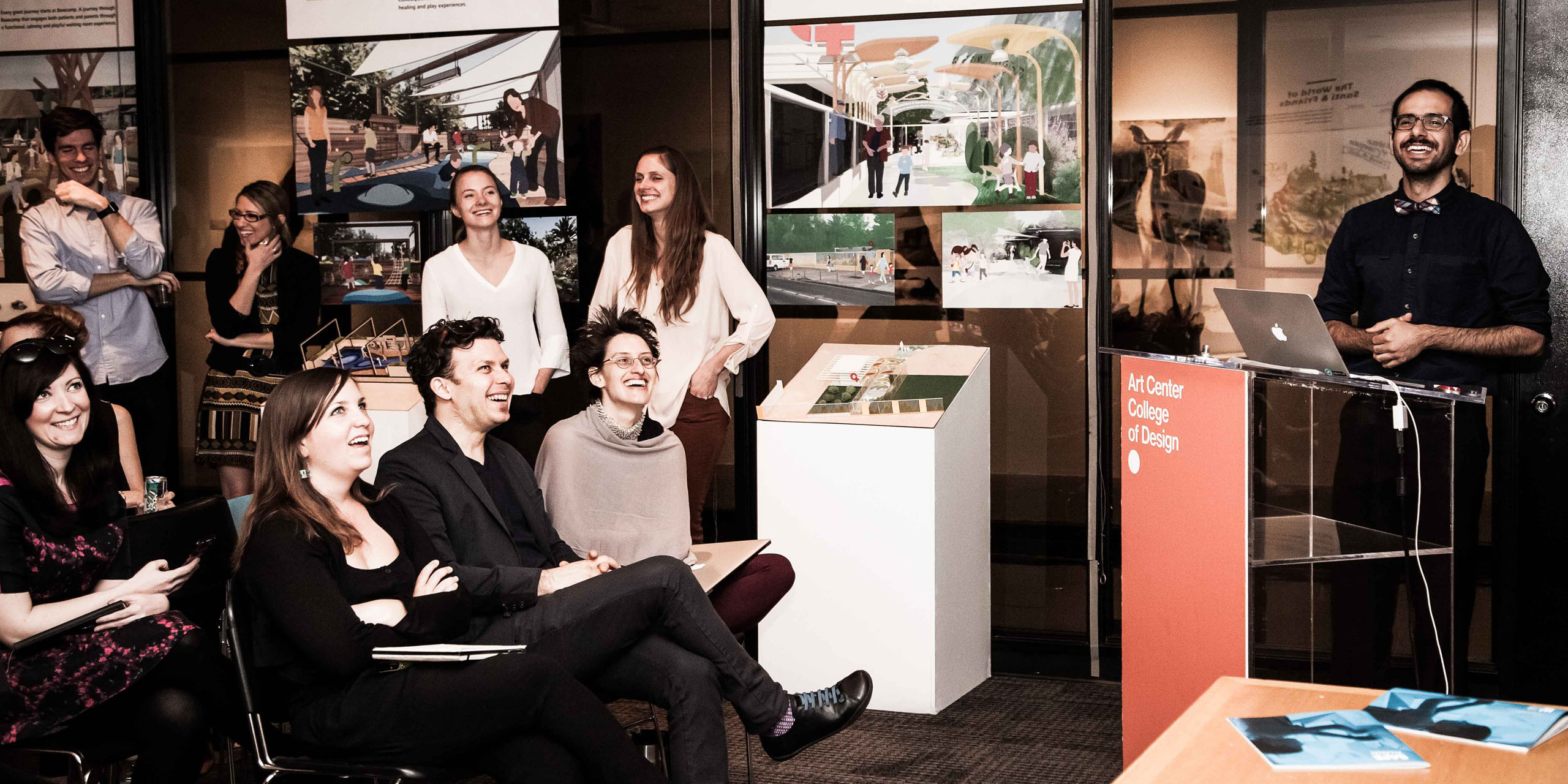
“This was incredible experience about teamwork. We had a lot of things happening in our design, lots of pieces coming together and we worked organically on the parts. We all understood the mission and how important this is, and we knew this had real potential to happen and we really wanted to do the best we could. We really wanted to show our ideas and to do what it takes. We had so many ideas in our head.”
– Ariane Fund, Student, Graduate Industrial Design
NEXT STEPS
A small group of students continued to work during the Summer of 2016 in a special Development Seminar to refine the projects. They returned to COANIQUEM to test prototypes and install select projects.
Click here for the latest updates on the Safe Niños Project.
Project Outcomes
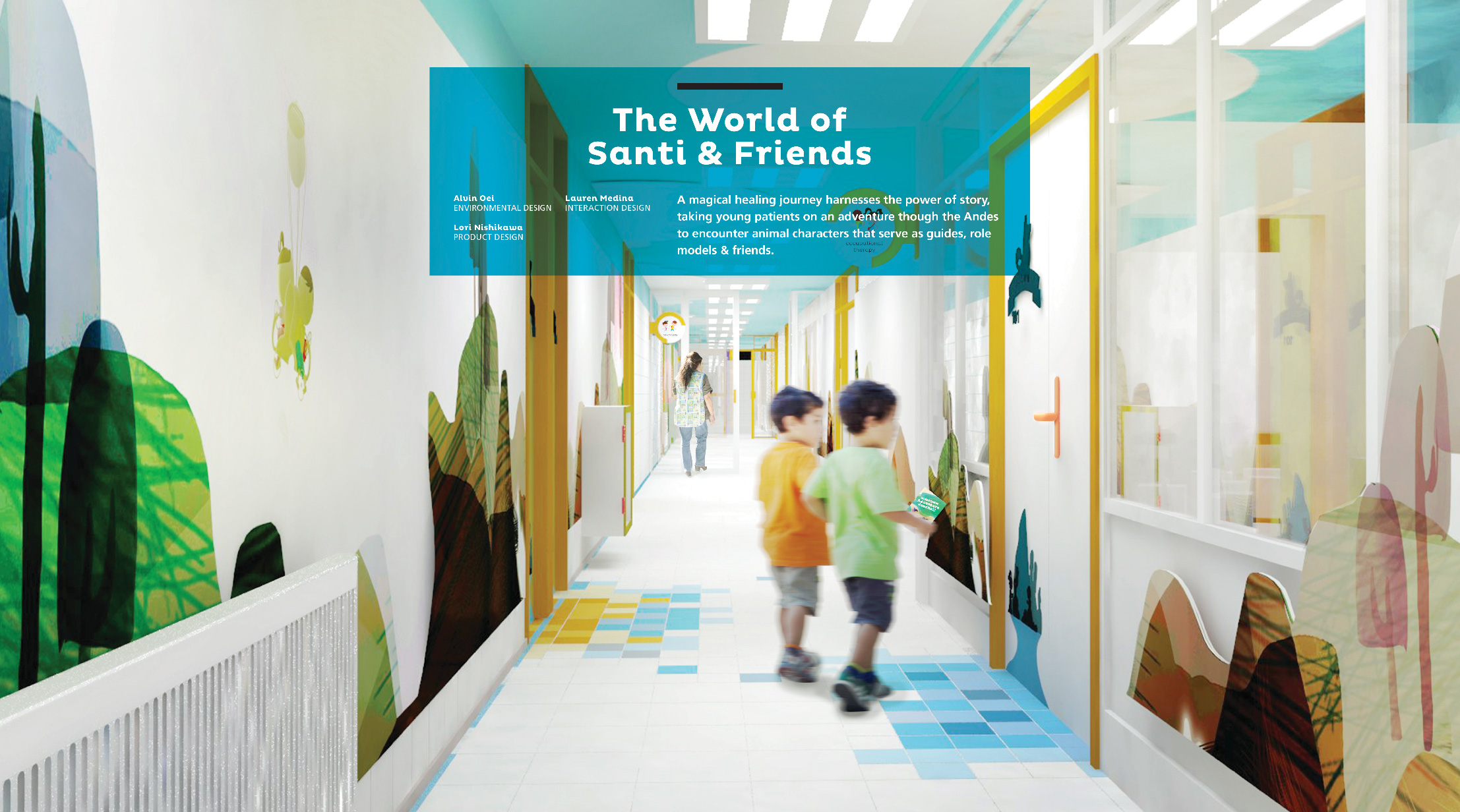 close
close
The World of Santi and Friends
Read moreAlvin Oei, Lauren Medina, Lori Nishikawa
The students decided to build on the work of pervious ArtCenter students by extending the brand of Santi, a character originally developed for COANIQUEM by students in the Spring 2013 Designmatters Graphic Design Studio The Healing Cloud, led by faculty Guillaume Wolf. Now used by COANIQUEM in national burn prevention campaigns and beloved in Chile by youngsters, a whole new cast of animal characters will accompany burn patients throughout their experience at COANIQUEM. When they first arrive, children will receive a storybook about the World of Santi, which describes new animal characters who will accompany child avatars Lucas and Camilla into a magical world and a healing journey. For the children, these animals will become their guardians, friends and mentors as they undergo treatments and therapies. Animal designs will be integrated into wall designs, footprints on the floor as directional wayfinders and other creative avenues. The ten treatment areas will have their own animal association, for example: the peacock with wound dressing, dogs with physical therapy, whales with hydro-therapy, hummingbirds with music therapy, etc. A symbolic representation of the end of a long path of treatment is the Healing Tree which children will read about in the book but also see represented in the COANIQUEM campus along with other character images and stories. Children will also receive a customized adventure journal and can receive a passport-type stamp every time they have a treatment.
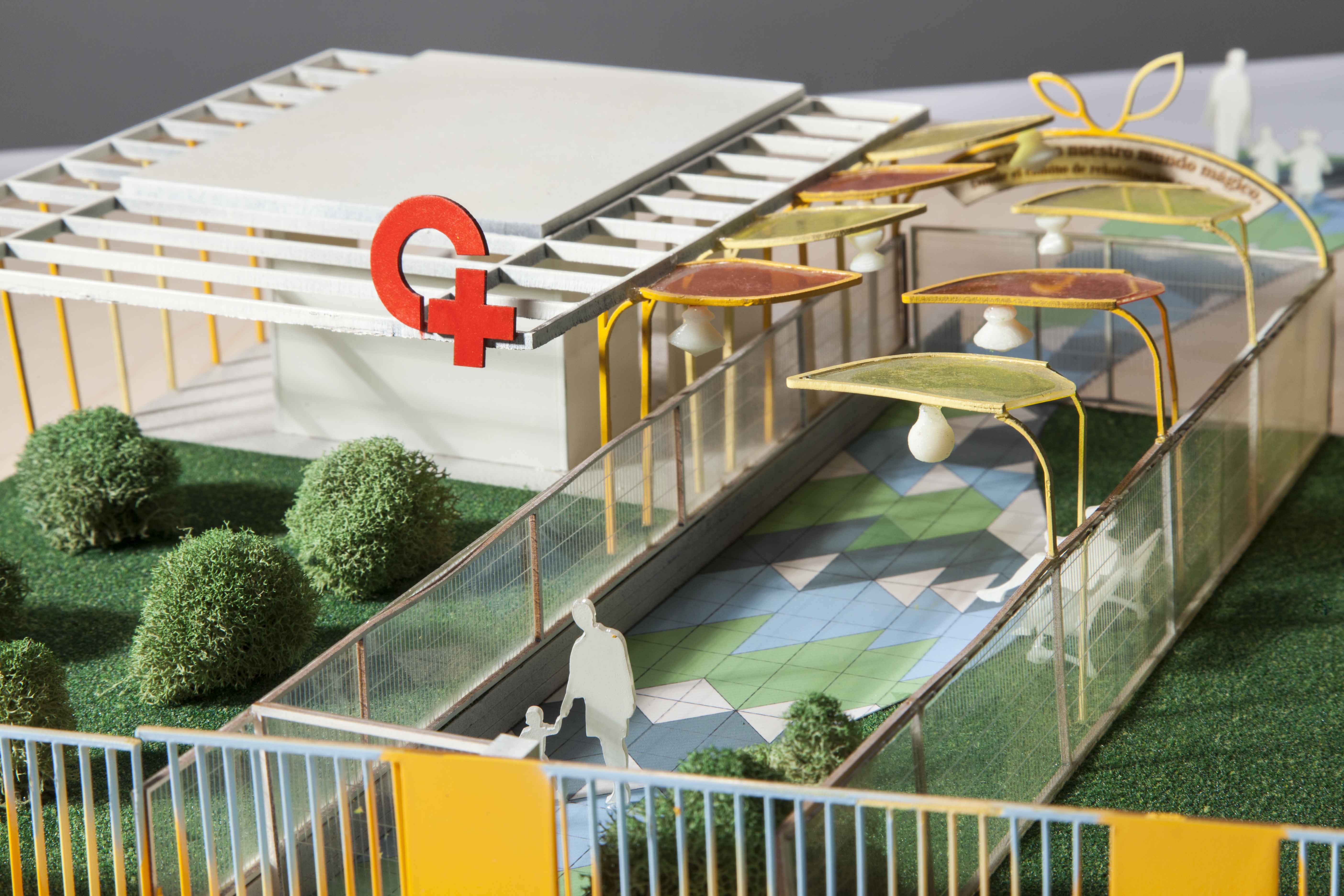 close
close
Welcoming Entry/Play Patio/ Healing Path/Basecamp
Read moreJulia Altschul, Eri Kawaguch-Murphy, Nicholas Jayanty, Dave Hansung Kim, Rachel Moore
Patients and families enter COANIQUEM through a redesigned front security gate that features colorful patterns and the COANIQUEM name. Once inside, families pass underneath shade sails that shelter from sun and rain, essential protection for burn survivors. Colored concrete pavers create a smooth walkway in this calm transition space. A mosaic path to the nearby chapel is landscaped with flowers; a colorful centerpiece is a representation of the Healing Tree. At the Base Camp (aka Waiting Room) a friendly checker/greeter welcomes families and, using a SMS tracker, notifies staff and specialists that appointments have arrived. The registration area can incorporate a private check-in area for parents who would like more discretion. Children have options for activities as they wait; craft tables, a story wall featuring Santi and friends, play zones as well as smaller alcoves for calm play and rest. Reconfigured seating – with comfortable cushions – encourages parents to interact with each other as they watch children play together. Just outside the waiting room is a reconfigured outdoor patio where children can play in a ship-themed environment using tactile elements that mimic physical and musical therapies skills: spinning wheels, tugging pulleys, etc
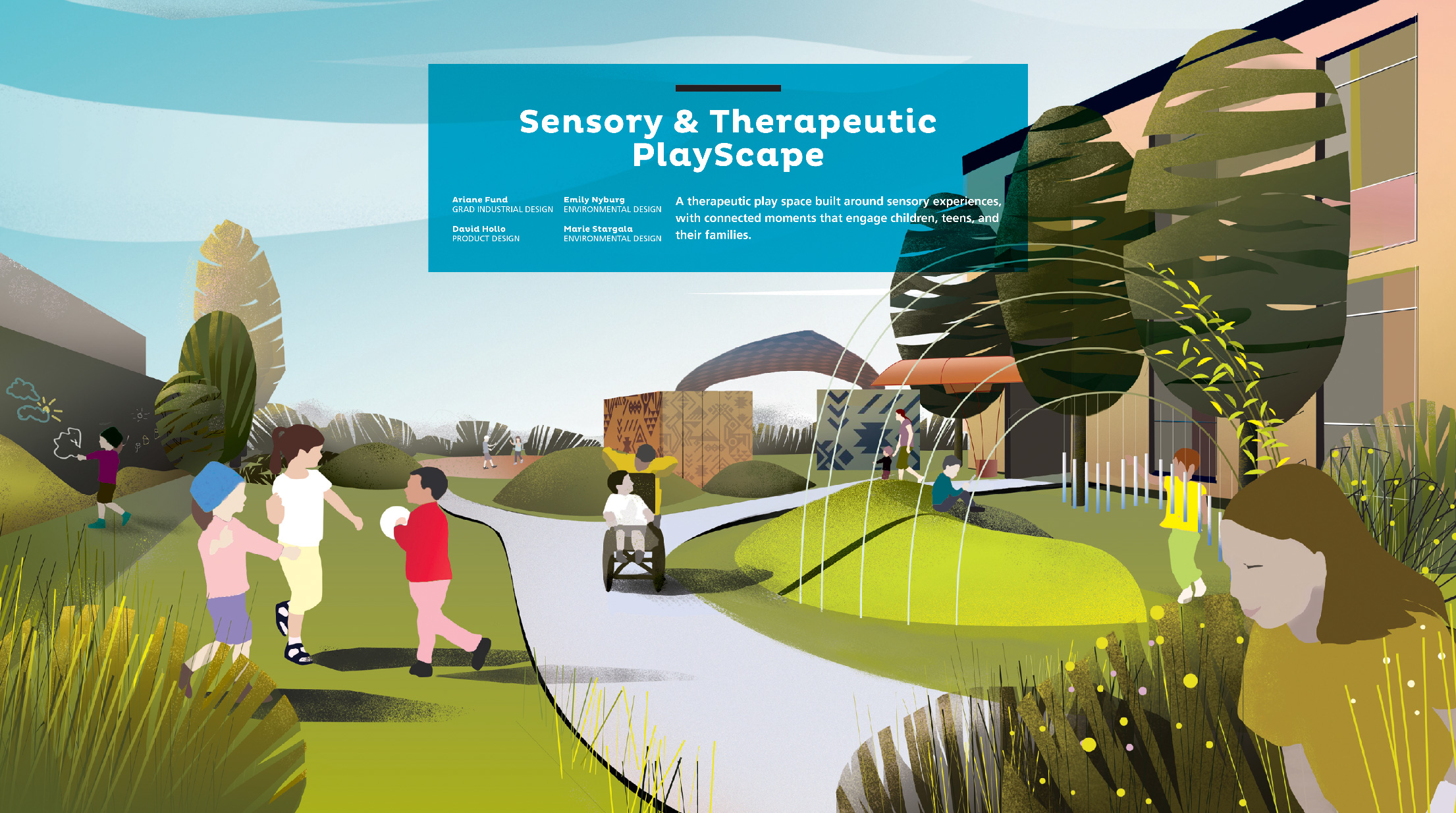 close
close
Sensory and Therapy PlayScape
Read moreAriane Fund, Emily Nyburg, David Hollo, Marie Stargala
Taking advantage of an unused area behind the Casabierta residential housing, outdoor playscapes present children, teens and grown-ups with both group interaction opportunities and places for solitary moments. Presented in three phases of installation, the revamped area will ultimately feature landscaped grassy mounds, shaded pathways, a mural installation, outdoor exercise equipment, an enhanced children’s play structure, a chalk drawing wall, a court for Zumba classes and a soccer field. In addition, updating lobby furnishings in the Casabierta would provide a more inviting area for social gathering.
 close
close
El Club: TeenZone
Read moreBehnia Rahmati
Targeting teenagers living in the Casabierta, these outdoors communal spaces are designed to engage young people in group fun as well as present private spaces for reflection and introspection. The design utilizes existing shipping containers on the site. Teens can artistically express themselves as they transform a shipping container into a work of art (graffiti wall). They can also hang out on hammocks stretched between containers. The overall space is also welcoming to music, dancing and casual group dynamics.
Booklet
-
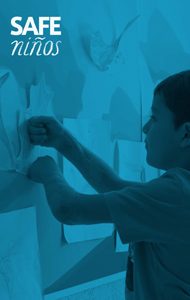
-
Safe Niños Booklet
View Booklet
Research Materials
-
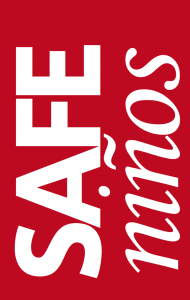
-
COANIQUEM: Safe Niños Methodology Cards
View Methodology Cards -
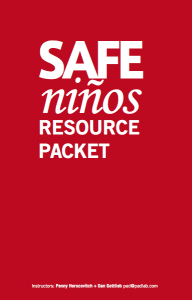
-
COANIQUEM: Safe Niños Resource Packet
View Resource Packet
Project Publicity
Awards
-
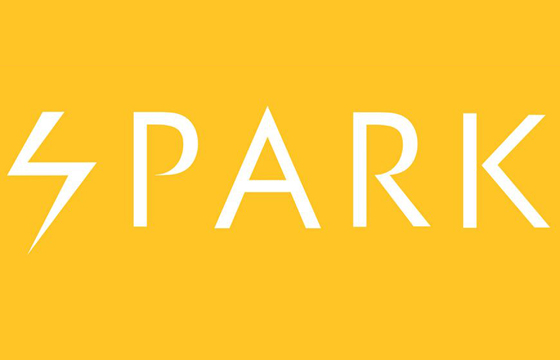

2016 Spark Awards
-


2016 Sappi Ideas That Matter
Alvin Oei/ Safe Niños: Healing Tree
-


2016 Denhart Family Sustainability Prize
Alvin Oei/ Safe Niños: Healing Tree
-
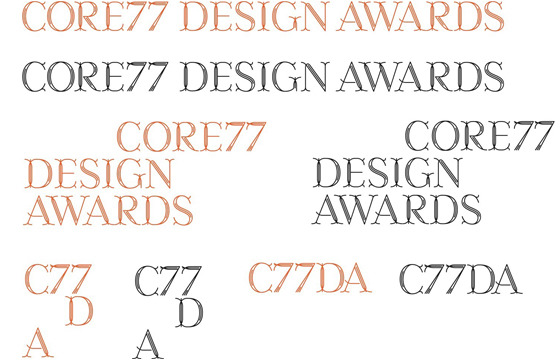

2017 Core77 Awards
Notable/ Alvin Oei/ Safe Niños: Healing Tree